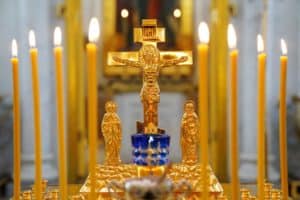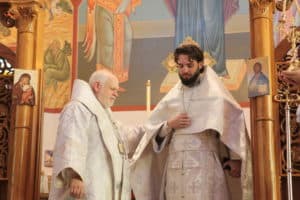Archbishop JOB (Osacky) of Chicago
Reverend Fathers, brothers and sisters in the Lord: Glory to Jesus Christ!
“…The Church is clothed in a beauty that surpasses all things earthly …”
(from the Glory… T.2, Vespers for the First Sunday of Great Lent)
Just about twenty-four hours ago at Vespers, these words were sung in the Orthodox Church throughout all the world – and what truly magnificent words they are! If we were to choose just a few words to summarize the cause of our celebration here this evening, we would not be remiss in choosing these very words; and we would do well to take a closer look at them:
“The Church is clothed in a beauty that surpasses all things earthly.”
The Church: We are here to celebrate the Church, the Body of Christ, the mystical communion of all Orthodox believers with our Lord Himself and with each other. If we stop and think about it, do we need any further reason to celebrate? What could bring us more joy than the knowledge that we are in Christ and with Christ, the incarnate, crucified, and risen Savior?
The historical events which are commemorated today remind us of this with clarity. In the eighth and ninth centuries, the Church was under siege by the iconoclasts: those who falsely taught that the veneration of icons was the practice of idolatry, and so all icons were to be removed from the churches and homes of the faithful and be destroyed. This evening we celebrate, in part, the memory of those who upheld the Holy Tradition of the Church; who stood firm against the heretics; who refused to break under pressure from both civil and misguided ecclesiastical authorities; who were not swayed, even when the heretical doctrines were the “majority opinion”; who were even ready to give their lives for the Truth. And they were prepared to do all this precisely because they understood how important the integrity of the Church is – not in some dry, academic way, but important for the very life of all those who are her members.
These faithful ones realized, to the very depths of their being, that what was at stake was our encounter, our communion, with God. Is God truly “the Lord who has revealed Himself to us” in His Only-begotten Son? Has the Unknowable made Himself known; has the Invisible granted us to “behold His glory”? The answer is yes – the only answer we find in the witness of the Apostles, in the Scriptures, in the writings of the Holy Fathers, and it is this answer which was defended and preached when the holy icons were restored on the First Sunday of Great Lent in the year 843.
The Church is clothed: It is a never-ending source of astonishment how the saints who composed the hymnography for all of the many services were inspired always to choose just exactly the best words to suit the particular hymn or occasion. Tonight, as we celebrate the holy icons, we could truthfully sing, “The Church possesses the icons,” which, of course, She does; we could say, “The Church guards the images,” which is unquestionably true. In many of our hymns we say that the Church is adorned, which She is. But this text says that the Church is clothed, which emphasizes how close and personal is the relationship between us and the holy icons.
Think of our earthly clothing. When a child is cold, giving him a coat is more than simply warming his body temperature. The coat also brings a sense of well-being and security. As adults, when we are preparing to go to the office, or work in the garden, or attend a banquet, we do not grab just anything which happens to be close at hand: it is much more personal than that. We think about what should be worn, and we choose clothing appropriate to the occasion and what is best for us. Conversely, if we wear what is inappropriate, we may be cold, or become embarrassed or feel out of place.
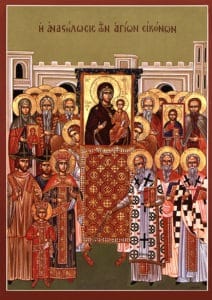 So it is with the icons in church. God has given them to us, not randomly or accidentally, but out of His wisdom and providence, and out of His great love and very specific care for us. He has clothed His Church in what is appropriate; that which will give us a sense of well-being and belonging – in other words, that which will manifest materially in our midst His holy and abiding presence and grace. (This is why it is so important that icons be constructed properly. They cannot be merely pretty or sentimental “holy pictures,” or paintings executed to extol the reputation of the artist. Good icons are always written/painted according to established canons, so they can serve the purpose for which God has ordained them.)
So it is with the icons in church. God has given them to us, not randomly or accidentally, but out of His wisdom and providence, and out of His great love and very specific care for us. He has clothed His Church in what is appropriate; that which will give us a sense of well-being and belonging – in other words, that which will manifest materially in our midst His holy and abiding presence and grace. (This is why it is so important that icons be constructed properly. They cannot be merely pretty or sentimental “holy pictures,” or paintings executed to extol the reputation of the artist. Good icons are always written/painted according to established canons, so they can serve the purpose for which God has ordained them.)
Thus, we do not only venerate the icons and carry them in procession, as is fitting and proper. Rather, we are also surrounded by them, wrapped up in them like wonderful garments. In the most beautiful Orthodox churches the world over, this is literally true: nearly every inch of wall and ceiling space is covered with the images of the Savior, His life, His most holy Mother, and the saints. When we enter piously into a church, we are struck immediately by the transformation from earthly to heavenly reality, and we are clothed, by the grace of God, as befits the citizens of His Kingdom.
The Church is clothed in a beauty: Good iconography is undoubtedly beautiful in the artistic sense of that word. The brush strokes, the details, the colors, the composition: all combine to form an image appealing to the eye. But when we learn to look at icons correctly, we discover a beauty which transcends our visual sensibilities. In other words, we find that there is indeed “more than meets the eye.”
The icons have been called “theology in color” (and so we usually say that an icon is “written” rather than “painted”). The real beauty of the icon is theological beauty: the image makes God’s word present before us. The person or event depicted in an icon is really with us – in our midst – not because there is something magic about the wood or paint, but because of the theological truth contained in it, which truth is always real and powerful.
For this same reason icons have also been called the “windows of heaven.” When we look into the icon, we see the heavenly reality, which is the only ultimate reality. Gazing upon the icons, we see the Savior who loves us, saves us, calls us, teaches us, judges the world, and rules the universe. We see in the Theotokos what virginity, motherhood, tenderness, and intercession are really meant to be by heavenly standards. We see in the saints what men and women are created to be, what is really possible through life in Christ, no matter what our earthly station or origins. We see in the Festal what has happened, still happens, and can happen because Christ has come into the world and has manifested His power among us.
Paradoxically, though the icons are filled with the power of God, an unmistakable aspect of their beauty is their serenity. If we look into the face, particularly the eyes, of the Lord or the saints in an icon, we find no confusion, aggravation, or aggression, but rather calm and surety. Even in icons of those events which included some form of upheaval – such as the Transfiguration, with the disciples tumbling to the ground, or the Crucifixion, which was accompanied by a rock-splitting earthquake – there is no sense of panic or dismay. Everyone is where he should be, doing what he should be doing. Again, this is theology: Christ comes, whether speaking a gentle word or rebuking the wind and waves, so that we might know the “peace which passes all understanding.”
The theological beauty of icons is expressed in their difference from other forms of painting in two very noticeable ways: light and perspective. In most paintings, light is depicted by use of shadows as coming from the right or left, or from above, and so on. In the icon, the light is shown coming from within the image itself. Christ, the Light of the world, needs no illumination from any earthly source, and those who are His receive the Light from Him who dwells within them.
Perspective, too, from a purely artistic point of view, is either lacking or is backwards, so to speak. This reverse perspective is apparent in many Festal icons, where figures in the foreground are smaller than those in the background (such as in the icons of the Nativity and the Transfiguration) because we are meant to be drawn away from earthly restrictions or perception and led into the central, salvific action which is depicted.
Icons appear, as well, to be two-dimensional. Once again, we are to abandon all earthly perspective, which is finite, and be elevated to the theological perspective, which is infinite. As an illustration of this, we might contrast the icon to a carved statue. When one walks around behind a statue, one sees the back of the statue. When one walks around to the back of an icon, there is nothing to be seen with the eyes. But when we see the icon’s theology; when we are drawn into the meaning of the icon, the “other side” of the icon is the Kingdom of Heaven.
This is the beauty of the icons: that we are given divine images through which we can perceive that which would otherwise escape our sight. This is the beauty with which the Church is clothed, the beauty which we celebrate today.
The Church is clothed in a beauty which surpasses all things earthly: These last words of the text are the words which now call us to examine our own hearts and minds in the light of all that is expressed in our celebration. As with any celebration in the Church, our joy and exaltation at the great grace which has been given to us must be accompanied by sincere thanksgiving and repentance. As the beauty so eloquently expressed in the holy icons, the beauty of Orthodox theology, is held up for us that we may rejoice in it, so it is held up also as the standard by which we must measure our participation in it and our faithfulness to it. The Feast itself reminds us of how very possible it is for us to stray from the path of the Truth if our sight is not fixed on the goal: salvation – the entrance into the Kingdom of Heaven.
We all too often allow earthly things to blur our sight, and, slowly but surely, the goal is obscured through our pride, stubbornness, and laziness. Values and notions which are foreign to the Holy Tradition are substituted for the beauty of the Truth, and before long we are no longer exalting the Triumph of Orthodoxy, but instead, “the triumph of us.” To the extent that we are faithful to the Orthodox way, we certainly may rejoice in our membership, our belonging to the Church. But we must not forget that it is not “our Church,” but Christ’s. It is Christ who has made the beautiful clothing which we put on, not we ourselves, and the beauty of this clothing is complete and perfect – it surpasses all things earthly. When we try to augment this beauty or add our own conditions for clothing ourselves in it, we end up doing the opposite: we diminish it for ourselves, and we obscure its witness to the world which so badly needs it.
Our self-examination in light of what is proclaimed here today is something which must be constant and continual, and it must take place at all levels of our life as the Church in North America. As the whole people of God on this continent, we exist in a tragic situation, a situation of our own making. Thanks be to God, we are united with each other in the Sacramental life, and there is much genuine love and care among us for each other, but ethnic and cultural differences continue to divide us in a very real way. We continue to insist that the beauty of Orthodoxy must have something earthly added to it – such as Russian, Greek, or American – in order to make it complete. How can this be, when the Church herself so clearly states that the beauty of Orthodoxy surpasses all things earthly?
At the parish level, we must strive to be the One, Holy, Catholic, and Apostolic Church in our local communities – the people of God, gathered together to worship the one True God, offering His love and salvation to all those around us. Our parishes must be truly evangelical: that is, centered on the preaching, the hearing and the learning of the Gospel of salvation, and the deeply spiritual and sacramental life which is the fruit of the Good News of the Lord Jesus Christ. The temples we build and have built must be to the glory of God. They must be the treasure-houses of the good things of God, not museums or our own earthly history or monuments to our own achievements. Our life as community in the parish must be a life of love, concern, and co-operation with each other for the good of all, “bearing one another’s burdens,” as St. Paul says. We must be on guard against becoming an organization absorbed by constant bickering over earthly things. All this is possible only through the grace of God, and we avail ourselves of this grace through prayer, fasting, and repentance, which is the way to surpass all things earthly.
At the personal level of our lives, we too must be ready to be clothed in the beauty which comes from God. We must not only reverently kiss the holy icons, but we must be drawn by them into life oriented toward and dedicated to God. There are many questions we can ask ourselves by which we may measure our lives. I offer here only a few.
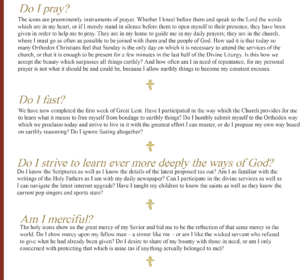 Do I pray? The icons are preeminently instruments of prayer. Whether I kneel before them and speak to the Lord the words which are in my heart, or if I merely stand in silence before them to open myself to their presence, they have been given in order to help me to pray. They are in my home to guide me in my daily prayers; they are in the church, where I must go as often as possible to be joined with them and the people of God. How sad it is that today so many Orthodox Christians feel that Sunday is the only day on which it is necessary to attend the services of the church, or that it is enough to be present for a few minutes in the last half of the Divine Liturgy. Is this how we accept the beauty which surpasses all things earthly? And how often am I in need of repentance, for my personal prayer is not what it should be and could be, because I allow earthly things to become my constant excuses.
Do I pray? The icons are preeminently instruments of prayer. Whether I kneel before them and speak to the Lord the words which are in my heart, or if I merely stand in silence before them to open myself to their presence, they have been given in order to help me to pray. They are in my home to guide me in my daily prayers; they are in the church, where I must go as often as possible to be joined with them and the people of God. How sad it is that today so many Orthodox Christians feel that Sunday is the only day on which it is necessary to attend the services of the church, or that it is enough to be present for a few minutes in the last half of the Divine Liturgy. Is this how we accept the beauty which surpasses all things earthly? And how often am I in need of repentance, for my personal prayer is not what it should be and could be, because I allow earthly things to become my constant excuses.
Do I fast? We have now completed the first week of Great Lent. Have I participated in the way which the Church provides for me to learn what it means to free myself from bondage to earthly things? Do I humbly submit myself to the Orthodox way which we proclaim today and strive to live in it with the greatest effort I can muster, or do I propose my own way based on earthly reasoning? Do I ignore fasting altogether?
Do I strive to learn ever more deeply the ways of God? Do I know the Scriptures as well as I know the details of the latest proposed tax cut? Am I as familiar with the writings of the Holy Fathers as I am with my daily newspaper? Can I participate in the divine services as well as I can navigate the latest internet upgrade? Have I taught my children to know the saints as well as they know the current pop singers and sports stars?
Am I merciful? The holy icons show us the great mercy of my Savior and bid me to be the reflection of that same mercy in the world. Do I show mercy upon my fellow man – a sinner like me – or am I like the wicked servant who refused to give what he had already been given? Do I desire to share of my bounty with those in need, or am I only concerned with protecting that which is mine (as if anything actually belonged to me)?
All of these questions, and many, many more bear directly on our celebration today because they point us to the attributes of those who know the Lord who has revealed Himself in the icons. If we ignore these questions or are indifferent to their answers, then our celebration is hollow, and we will find ourselves unable to clothe ourselves with the garments which God gives us.
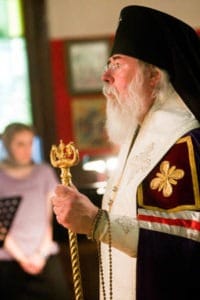
Having just this past week received once again the marvelous grace of the Great Canon of St Andrew, we can paraphrase a few of his words as we exalt and venerate the icons of true Orthodox theology: We have been given examples of those who, before and after the Law, have obeyed the Lord; let us imitate these examples while there is yet time, that our garment which is in tatters may be replaced by the beauty which God offers.
Let us give thanks to the Lord for this beauty which clothes the Church; the beauty which surpasses all things earthly; the beauty of the holy icons; the beauty of the Triumph of Orthodoxy. And may God grant us all a humble and contrite heart ready to receive His gift, that we may devoutly walk the path of Great Lent to the glory of the Holy Pascha, in the name of the Father and of the Son and of the Holy Spirit. Amen.

